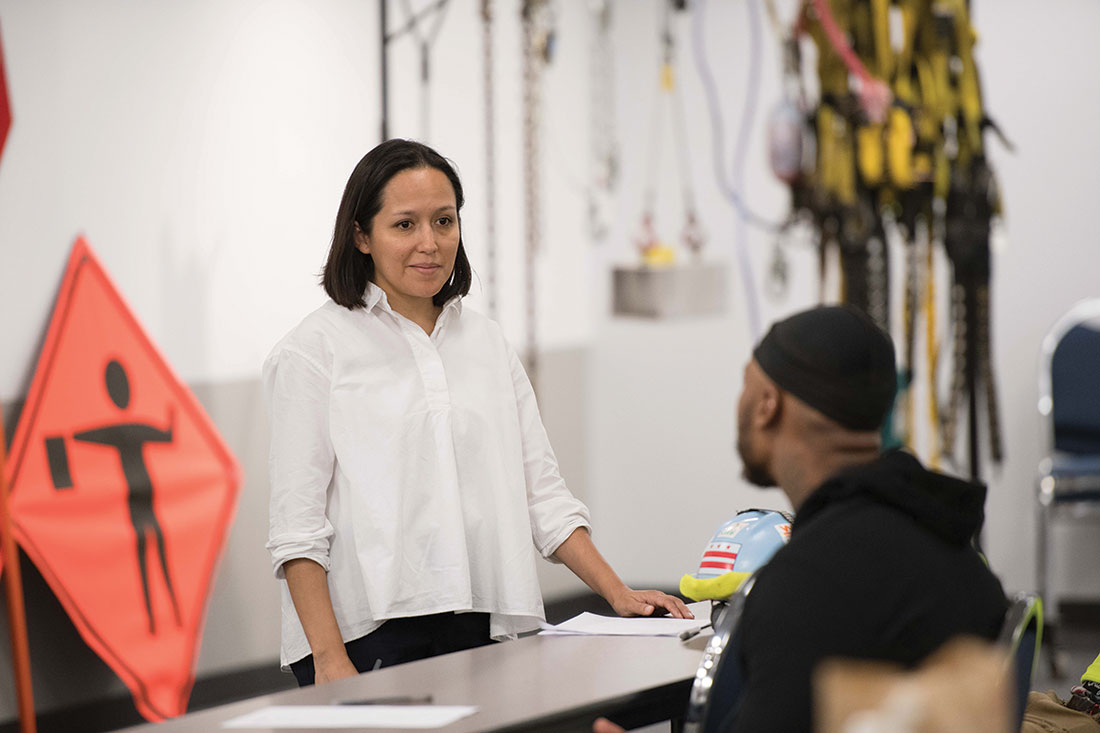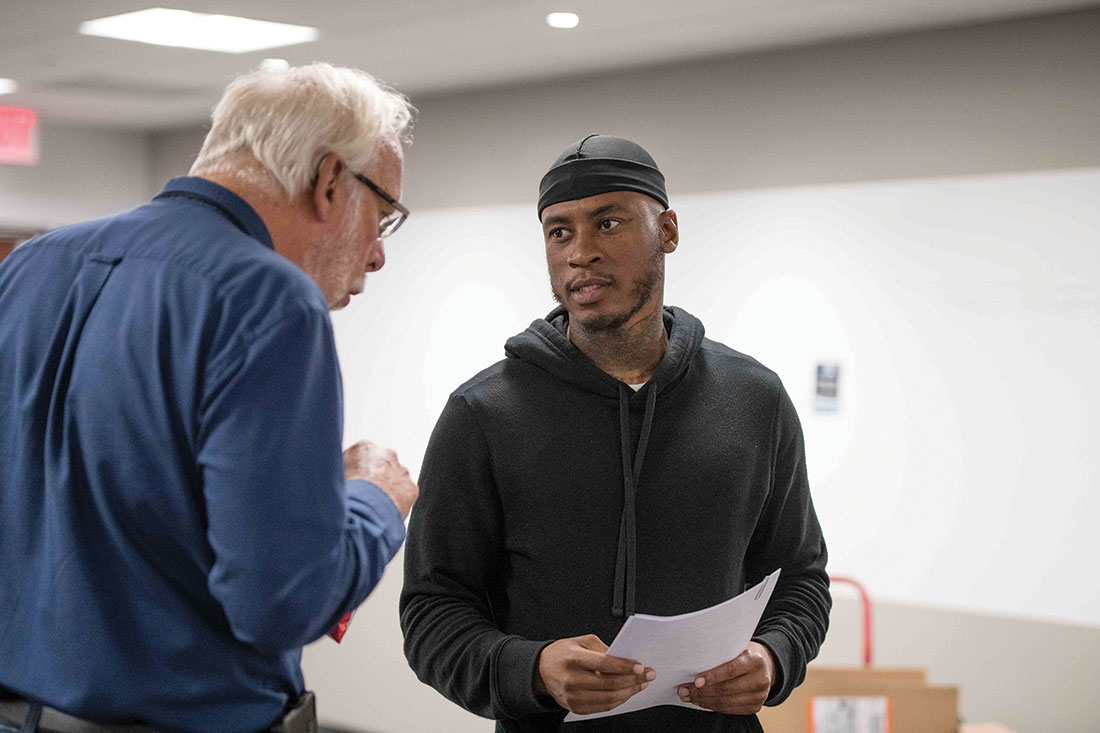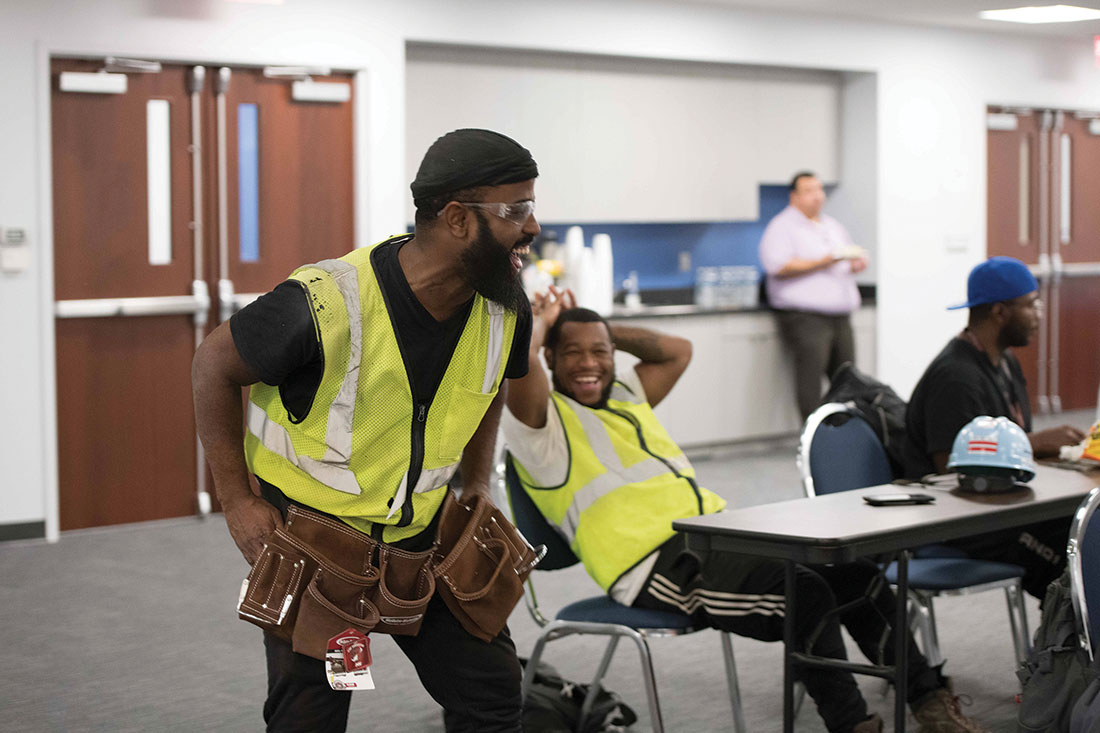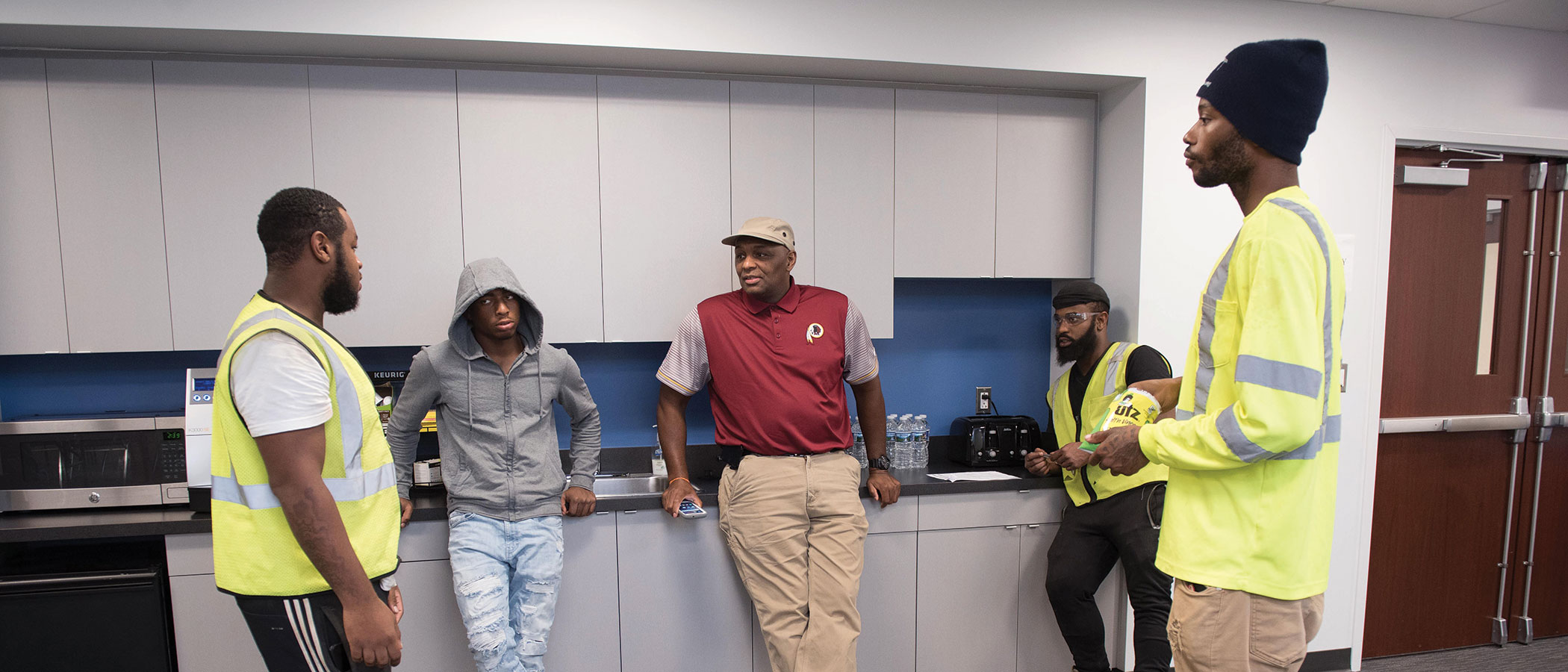Miller & Long Concrete Construction has a long-standing commitment to workforce development and training through its existing pre-apprenticeship programs. It recently added to its efforts to expand the pool of qualified laborers in the construction industry through a program supported by the Department of Employment Services. In Part 2 of a two-part series, JOBS Coalition Pathways highlights the classroom training component of this 12-week pre-apprenticeship program and how it helps prepare those new to the construction field for future career success.
It’s just after noon on a Friday, and eight guys are scattered across the room — seated along three long rows of tables in the basement of Miller & Long’s Training Center in Bethesda, Maryland, where instructor Karen Brioso discusses the ins and outs of worksite safety.
“Pay attention. Here and there, look up and see where the crane is moving,” Brioso, a safety manager at Miller & Long Concrete Construction, tells the group of pre-apprentices.
“Every time I walk, I look up first,” one young man responds.
“Listen for the whistles. Foremen have whistles they will start blowing and the crane has a horn. Don’t ignore those sounds. Those sounds are alerting you of a danger,” she continues while flipping through a series of projected images with titles like “Struck by Flying Objects” and “Cranes and Heavy Equipment.”
This mandatory class is one of a string of safety and professional development trainings held as part of the 12-week pre-apprenticeship program supported by the Department of Employment Services. And the Occupational Safety and Health Administration’s OSHA10 construction training — a 10-and-a-half-hour, three-day course — is a critical component for the pre-apprentices.
“The type of industry in which they work is very dangerous, so it’s to teach these guys how to recognize hazards and prevent them from getting hurt on the job site,” says Brioso of the training, which is a primer for construction newcomers. “This is to add to their knowledge. The more knowledge your people have, the safer they are going to be.”
On this day, Brioso starts with in-class exercises to identify safety hazards, like those related to crane swing radius and excavations. The students are attentive, writing in their workbooks and engaging in class discussions call-and-response style. The curriculum for this training started with an introduction to OSHA, and continued with discussions on how to file an OSHA complaint, fall protection, and electric and health hazards in construction and inspection tools. “If you’re not trained, then the only way for you to find out is if you get hurt,” adds Brioso. “That is what we’re trying to prevent.”

Grabbing the Golden Ring
But the pre-apprenticeship program extends beyond working to ensure one’s well-being on the job. Just ask Matthew Aguilar, who learned about the opportunity months after landing a laborer position with Miller & Long.
“It helps out people,” assures Aguilar, a carpenter’s helper.
Through the program, he continues, “I’ve learned that I can push past my limits.” So, he has set his sights on becoming an engineer and is optimistic about getting help along the way. “I’m just trusting the powers that be and the people who are in charge,” says Aguilar of those overseeing the training program. “They say they are going to give me an opportunity, so I’m just gonna wait to grab that opportunity.”
Aguilar is not alone. Others hired into the program are also looking ahead, and Miller & Long is providing the resources to help them succeed. “Everyone is showing extreme effort and willingness to go forward,” says Romina Byrd, the company’s director of education and training.
When Kenneth Glover doles out advice and life lessons to the pre-apprentices of this class — the majority of whom are formerly incarcerated — he is speaking from experience. That’s because he too is a returning citizen. “I know what it takes to get to another level,” says Glover, a human resources assistant for Miller & Long, who vividly remembers his days as a laborer. He started with the company in 2003 as a carpenter helper.
For many of these men passing through the doors of the Training Center, Glover has become an unoffcial mentor, regularly devoting time to help keep each one on track. He calls them after work and invites them to call him — all in an effort to help address a patchwork of issues outside of the workplace that can derail their progress. Those challenges include housing, family issues and a lack of support, according to Glover.

The program provides additional classroom trainings covering areas such as anger management, budgeting and financial literacy aimed at addressing these and other challenges. “Some probably haven’t worked on their issues before coming home,” he adds.
While the company is giving the opportunity, the responsibility ultimately falls on each pre- apprentice. And that means eliminating the excuses, Glover says.
Setting Priorities
It’s the final day of class in September, and there’s a steady stream of pre-apprentices anxious to offcially become graduates. Glover steps to the front of the room and asks the guys about their tools. One retorts that he’s lost his hammer. Glover goes all in: “Time out … come on, come on, what? This is our profession. Listen, when I was a carpenter, you know how many tools I actually lost? But I had to go buy me new ones. This is y’alls trade. You have to be invested in yourself.”
Glover is never hesitant to take a “tough love” approach, and throughout the class it’s easy to catch him pulling a pre-apprentice aside for a talk or holding court with a small group — always giving it to them straight. “I just try to walk my walk, be consistent on what I preach and teach, and live it. And I show it to them,” he says. “I was once in their seat … so I know what it’s gonna take for them to make it through this program.”

According to Byrd, about 90 percent of the students want to pursue apprenticeship training, an endeavor Miller & Long is supporting by hosting an on-site signup for those interested on graduation day. It’s something Dontrell Deaner is looking forward to as he has his sights set on a carpentry apprenticeship.
“I feel like I should take advantage of the opportunity that’s been presented to me. I’m just going to put my all into it and hopefully come out successful,” says Deaner, 28, who learned about the pre-apprenticeship program through DOES.
“We supported this program helping to get D.C. residents into apprenticeships. We are very proud of these guys having completed this and pursuing their careers in construction,” says Randall Shannon, a workforce development specialist at DOES’ Office of Apprenticeship, in attendance for the last session.
As the newly minted grads accepted their fully-equipped, leather tool belts, signaling their graduation, Glover urges them to stay focused on the big picture. “This program is giving you a chance to learn a trade that no one can take away,” he says, and, instilling “a sense of pride and showing someone cares.” At the same time, Miller & Long is advancing its future, as “hopefully these young men will become carpenters and foremen,” Glover adds.
Deaner, for one, says he is feeling good about what he’s already accomplished and the journey ahead: “This is just my first round of the fight, and there’s a plenty more to come. I just want to conquer them all.”

